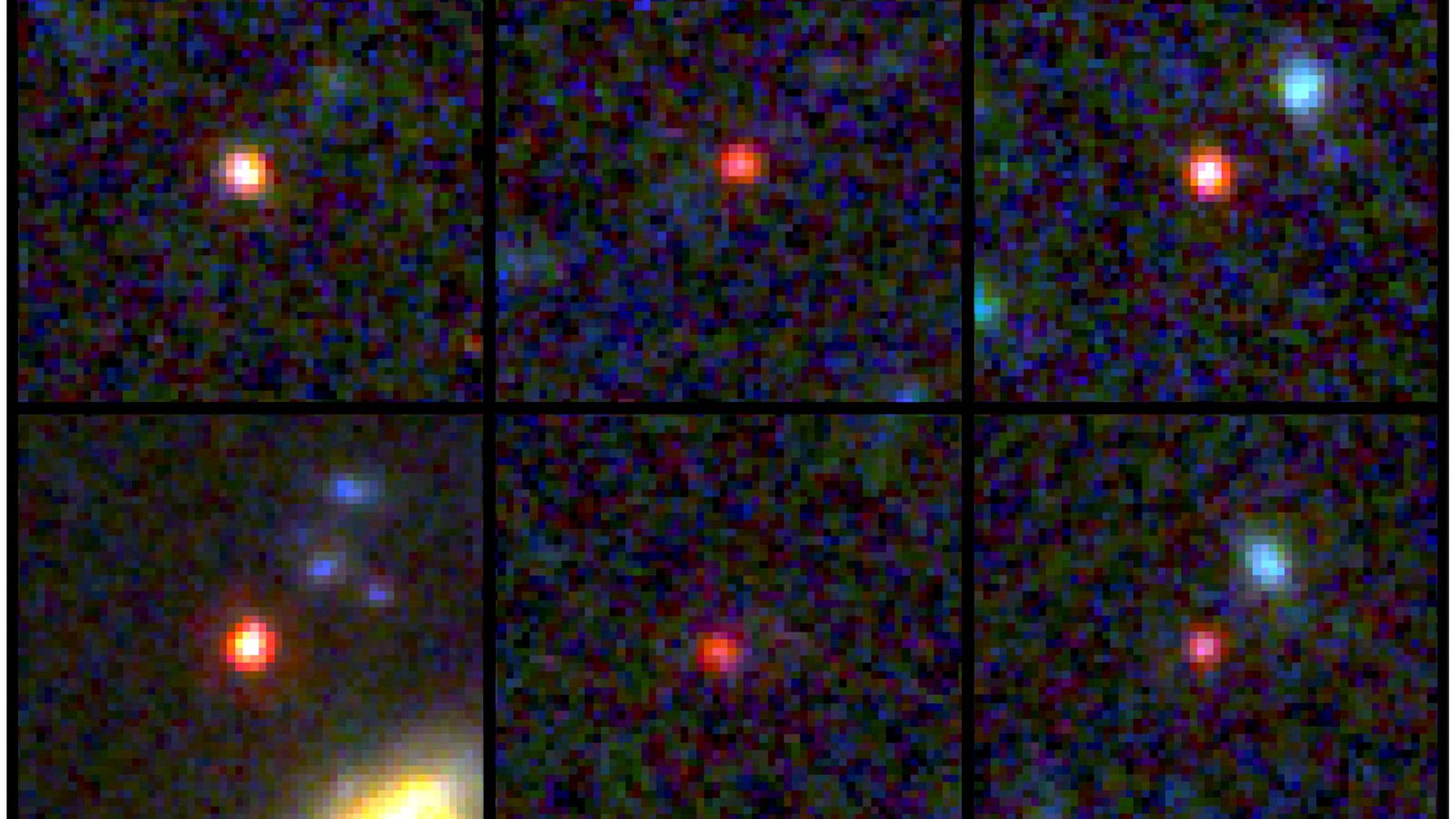Six ancient ‘universe breaker’ galaxies discovered
The galaxies date back to within 600 million years of the Big Bang.
Niamh Lynch
Sky News reporter @niamhielynch
Thursday 23 February 2023 06:22, UK
Images of six candidate massive galaxies, seen 540 million to 770 million years after the Big Bang, are shown in this undated handout image based on observations by NASA's James Webb Space Telescope, as one of them (bottom left) could contain as many stars as our present-day Milky Way, but is 30 times more compact. NASA, ESA, CSA, I. Labbe (Swinburne University of Technology)/Handout via REUTERS THIS IMAGE HAS BEEN SUPPLIED BY A THIRD PARTY. MANDATORY CREDIT
Image:
Images of six newly discovered massive galaxies that date back to 600 million years of the Big Bang.
Why you can trust Sky News
Six massive ancient galaxies, which astronomers are calling “universe breakers” appear to have been discovered, which may upend existing theories of cosmology.
The galaxies, detected by the £8.3bn James Webb telescope, are believed to date back to within around 600 million years of the Big Bang.
While the year-old telescope has spotted older galaxies dating to within 300 million years of the beginning of the universe, the size and maturity of the mega-galaxies have stunned scientists.
Astronomers thought they had made a mistake when they spotted the “monsters”.
Lead researcher Ivo Labbe, from Australia’s Swinburne University of Technology, said: “While most galaxies in this era are still small and only gradually growing larger over time, there are a few monsters that fast-track to maturity. Why this is the case or how this would work is unknown.”
“We were mind-blown, kind of incredulous,” Mr Labbe said.
The six galaxies appear to weigh billions of times more than our sun, according to the scientists who published their results in the journal Nature.
MORE ON JAMES WEBB SPACE TELESCOPE
This image by the NASA/ESA/CSA James Webb Space Telescope…s Near-InfraRed Camera (NIRCam) features the central region of the Chameleon I dark molecular cloud, which resides 630 light years away. The cold, wispy cloud material (blue, centre) is illuminated in the infrared by the glow of the young, outflowing protostar Ced 110 IRS 4 (orange, upper left). The light from numerous background stars, seen as orange dots behind the cloud, can be used to detect ices in the cloud, which absorb the starlight passing through them… An international team of astronomers has reported the discovery of diverse ices in the darkest, coldest regions of a molecular cloud measured to date by studying this region. This result allows astronomers to examine the simple icy molecules that will be incorporated into future exoplanets, while opening a new window on the origin of more complex molecules that are the first step in the creation of the building blocks of life. [Image Description: A large, dark cloud is contained within the frame. In its top half it is textured like smoke and has wispy gaps, while at the bottom and at the sides it fades gradually out of view. On the left are several orange stars: three each with six large spikes, and one behind the cloud which colours it pale blue and orange. Many tiny stars are visible, and the background is black.]
NASA’s James Webb Space Telescope finds signs of ‘building blocks for life’ in icy clouds
Handout image issued by the Science and Technology Facilities Council of NGC 346 – a cluster of stars in the Small Magellanic Cloud taken by the James Webb Space Telescope.
New image from James Webb Space Telescope offers insights into how first stars formed more than 10 billion years ago
James Webb Space Telescope captures view of Neptune's rings
Credit: NASA, ESA, CSA, STScI
James Webb space telescope captures Neptune rings and moons
Related Topics:
James Webb Space Telescope
But they are believed to be extremely compact, squeezing in as many stars as the Milky Way but in a relatively tiny slice of space.
Pennsylvania State University’s Joel Leja, who took part in the study, said the discovery “upends what many of us had thought was settled science”.
Read more:
NASA’s James Webb Space Telescope finds signs of ‘building blocks for life’ in icy clouds
“It turns out we found something so unexpected it actually creates problems for science. It calls the whole picture of early galaxy formation into question.”
Existing theories suggest that after a period of rapid expansion, the universe spent several hundred million years cooling down enough for gas to coalesce and collapse into the first stars and galaxies began to form. This period is known as the dark ages.
The observations of the new galaxies were among the data set that came from the Webb telescope.
NASA and the European Space Agency’s Webb is considered the successor to the Hubble Space Telescope which was launched almost 33 years ago.
Unlike the Hubble, the bigger and more powerful Webb can see through clouds of dust with its infrared vision and find previously undiscovered galaxies.
Scientists hope to eventually observe the first galaxies and stars formed after the creation of the universe 13.8 billion years ago.
The research team is still waiting for official confirmation of the galaxies through sensitive spectroscopy. Mr Leja said it’s possible that a few objects might not be galaxies, but obscured supermassive black holes.
While some may prove to be smaller, “odds are good at least some of them will turn out to be” galactic giants, Mr Labbe said. “The next year will tell us.”
Related Topics
James Webb Space Telescope




























![Qatar Labor Law In 2020??? [UPDATES]](https://welcomeqatar.com/wp-content/uploads/2020/12/Qatar-Labor-Law-1-696x366-1-324x366.jpg)

